Analyzing the Economic Impacts of US-China Trade Wars on Australia
VerifiedAdded on 2023/06/06
|8
|1929
|327
Report
AI Summary
This report examines the economic implications of the US-China trade war for Australia. Drawing upon a KPMG report, the analysis highlights the impact of tariffs and trade disagreements on Australia's GDP, exports, and job market. The report details the escalation of the trade war, including key events and retaliatory measures. It presents three scenarios modeled by KPMG, exploring the potential effects of limited escalation, full escalation with no contagion, and full escalation with full contagion. The conclusion emphasizes the negative consequences of the trade war for all countries involved and advises Australian policymakers to resist pressures for increased tariffs. The report also includes a comprehensive reference list and bibliography.

Running head: ECONOMICS
Economics
Name of the student
Name of the university
Author note
Economics
Name of the student
Name of the university
Author note
Paraphrase This Document
Need a fresh take? Get an instant paraphrase of this document with our AI Paraphraser
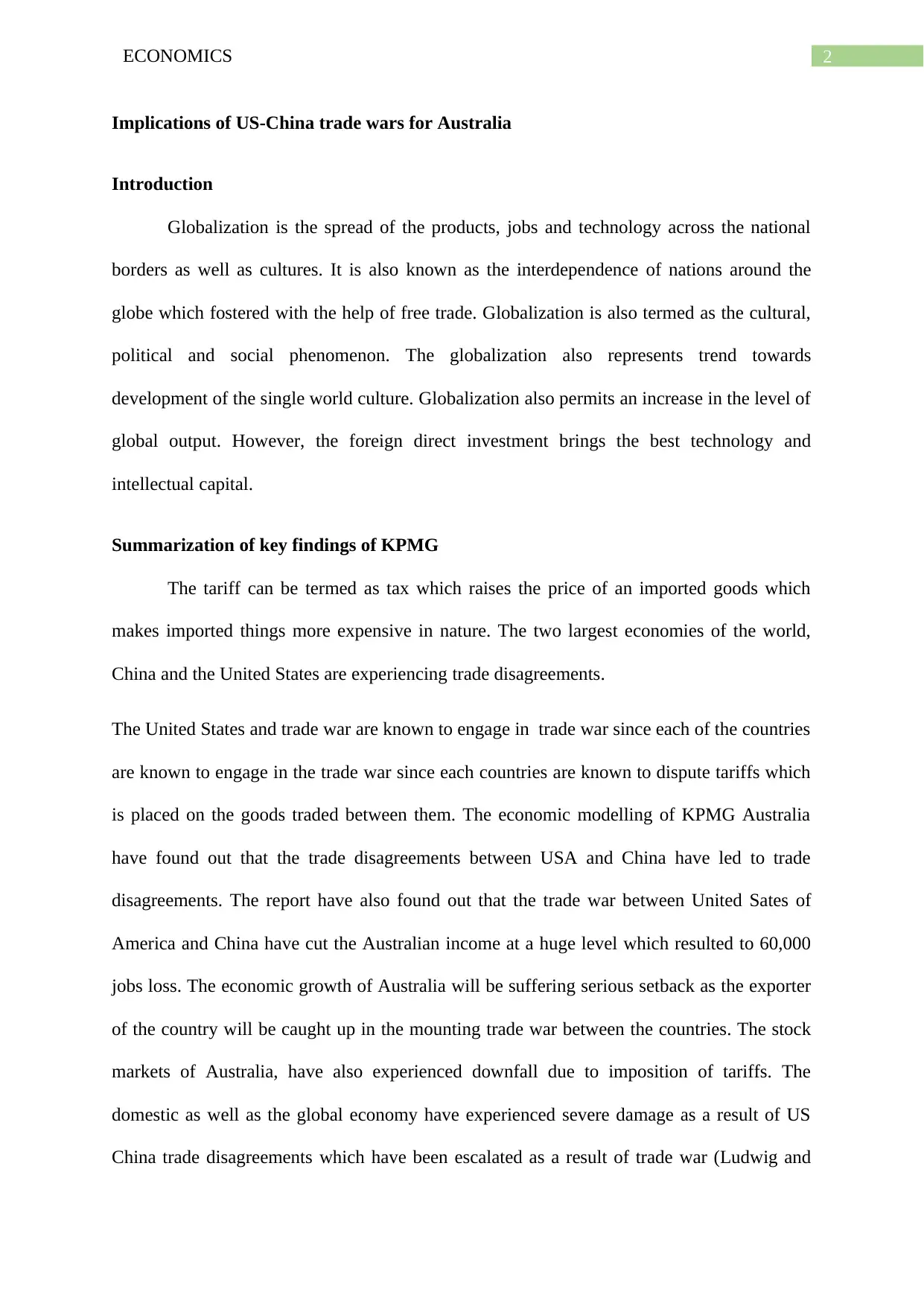
2ECONOMICS
Implications of US-China trade wars for Australia
Introduction
Globalization is the spread of the products, jobs and technology across the national
borders as well as cultures. It is also known as the interdependence of nations around the
globe which fostered with the help of free trade. Globalization is also termed as the cultural,
political and social phenomenon. The globalization also represents trend towards
development of the single world culture. Globalization also permits an increase in the level of
global output. However, the foreign direct investment brings the best technology and
intellectual capital.
Summarization of key findings of KPMG
The tariff can be termed as tax which raises the price of an imported goods which
makes imported things more expensive in nature. The two largest economies of the world,
China and the United States are experiencing trade disagreements.
The United States and trade war are known to engage in trade war since each of the countries
are known to engage in the trade war since each countries are known to dispute tariffs which
is placed on the goods traded between them. The economic modelling of KPMG Australia
have found out that the trade disagreements between USA and China have led to trade
disagreements. The report have also found out that the trade war between United Sates of
America and China have cut the Australian income at a huge level which resulted to 60,000
jobs loss. The economic growth of Australia will be suffering serious setback as the exporter
of the country will be caught up in the mounting trade war between the countries. The stock
markets of Australia, have also experienced downfall due to imposition of tariffs. The
domestic as well as the global economy have experienced severe damage as a result of US
China trade disagreements which have been escalated as a result of trade war (Ludwig and
Implications of US-China trade wars for Australia
Introduction
Globalization is the spread of the products, jobs and technology across the national
borders as well as cultures. It is also known as the interdependence of nations around the
globe which fostered with the help of free trade. Globalization is also termed as the cultural,
political and social phenomenon. The globalization also represents trend towards
development of the single world culture. Globalization also permits an increase in the level of
global output. However, the foreign direct investment brings the best technology and
intellectual capital.
Summarization of key findings of KPMG
The tariff can be termed as tax which raises the price of an imported goods which
makes imported things more expensive in nature. The two largest economies of the world,
China and the United States are experiencing trade disagreements.
The United States and trade war are known to engage in trade war since each of the countries
are known to engage in the trade war since each countries are known to dispute tariffs which
is placed on the goods traded between them. The economic modelling of KPMG Australia
have found out that the trade disagreements between USA and China have led to trade
disagreements. The report have also found out that the trade war between United Sates of
America and China have cut the Australian income at a huge level which resulted to 60,000
jobs loss. The economic growth of Australia will be suffering serious setback as the exporter
of the country will be caught up in the mounting trade war between the countries. The stock
markets of Australia, have also experienced downfall due to imposition of tariffs. The
domestic as well as the global economy have experienced severe damage as a result of US
China trade disagreements which have been escalated as a result of trade war (Ludwig and
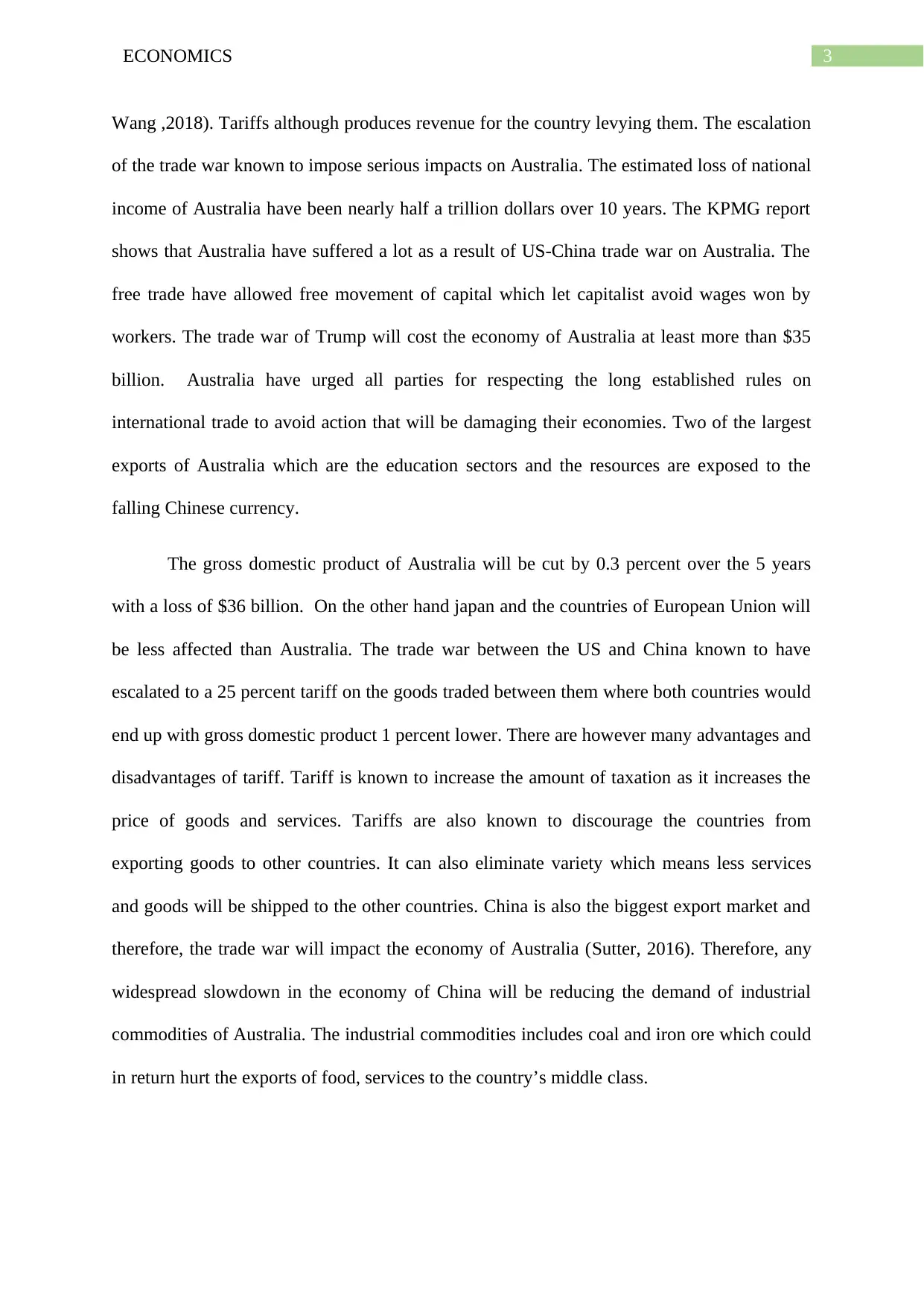
3ECONOMICS
Wang ,2018). Tariffs although produces revenue for the country levying them. The escalation
of the trade war known to impose serious impacts on Australia. The estimated loss of national
income of Australia have been nearly half a trillion dollars over 10 years. The KPMG report
shows that Australia have suffered a lot as a result of US-China trade war on Australia. The
free trade have allowed free movement of capital which let capitalist avoid wages won by
workers. The trade war of Trump will cost the economy of Australia at least more than $35
billion. Australia have urged all parties for respecting the long established rules on
international trade to avoid action that will be damaging their economies. Two of the largest
exports of Australia which are the education sectors and the resources are exposed to the
falling Chinese currency.
The gross domestic product of Australia will be cut by 0.3 percent over the 5 years
with a loss of $36 billion. On the other hand japan and the countries of European Union will
be less affected than Australia. The trade war between the US and China known to have
escalated to a 25 percent tariff on the goods traded between them where both countries would
end up with gross domestic product 1 percent lower. There are however many advantages and
disadvantages of tariff. Tariff is known to increase the amount of taxation as it increases the
price of goods and services. Tariffs are also known to discourage the countries from
exporting goods to other countries. It can also eliminate variety which means less services
and goods will be shipped to the other countries. China is also the biggest export market and
therefore, the trade war will impact the economy of Australia (Sutter, 2016). Therefore, any
widespread slowdown in the economy of China will be reducing the demand of industrial
commodities of Australia. The industrial commodities includes coal and iron ore which could
in return hurt the exports of food, services to the country’s middle class.
Wang ,2018). Tariffs although produces revenue for the country levying them. The escalation
of the trade war known to impose serious impacts on Australia. The estimated loss of national
income of Australia have been nearly half a trillion dollars over 10 years. The KPMG report
shows that Australia have suffered a lot as a result of US-China trade war on Australia. The
free trade have allowed free movement of capital which let capitalist avoid wages won by
workers. The trade war of Trump will cost the economy of Australia at least more than $35
billion. Australia have urged all parties for respecting the long established rules on
international trade to avoid action that will be damaging their economies. Two of the largest
exports of Australia which are the education sectors and the resources are exposed to the
falling Chinese currency.
The gross domestic product of Australia will be cut by 0.3 percent over the 5 years
with a loss of $36 billion. On the other hand japan and the countries of European Union will
be less affected than Australia. The trade war between the US and China known to have
escalated to a 25 percent tariff on the goods traded between them where both countries would
end up with gross domestic product 1 percent lower. There are however many advantages and
disadvantages of tariff. Tariff is known to increase the amount of taxation as it increases the
price of goods and services. Tariffs are also known to discourage the countries from
exporting goods to other countries. It can also eliminate variety which means less services
and goods will be shipped to the other countries. China is also the biggest export market and
therefore, the trade war will impact the economy of Australia (Sutter, 2016). Therefore, any
widespread slowdown in the economy of China will be reducing the demand of industrial
commodities of Australia. The industrial commodities includes coal and iron ore which could
in return hurt the exports of food, services to the country’s middle class.
⊘ This is a preview!⊘
Do you want full access?
Subscribe today to unlock all pages.

Trusted by 1+ million students worldwide
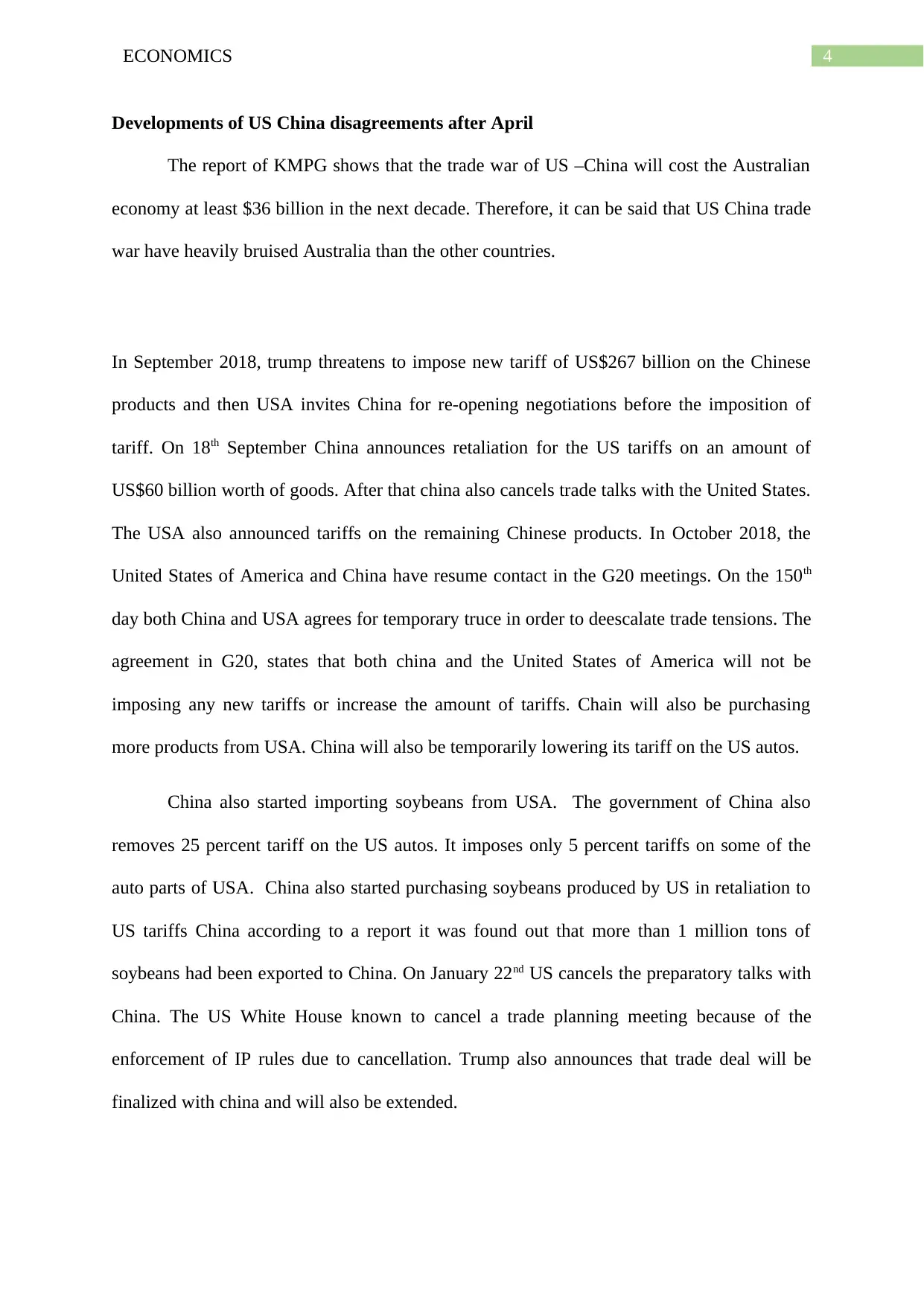
4ECONOMICS
Developments of US China disagreements after April
The report of KMPG shows that the trade war of US –China will cost the Australian
economy at least $36 billion in the next decade. Therefore, it can be said that US China trade
war have heavily bruised Australia than the other countries.
In September 2018, trump threatens to impose new tariff of US$267 billion on the Chinese
products and then USA invites China for re-opening negotiations before the imposition of
tariff. On 18th September China announces retaliation for the US tariffs on an amount of
US$60 billion worth of goods. After that china also cancels trade talks with the United States.
The USA also announced tariffs on the remaining Chinese products. In October 2018, the
United States of America and China have resume contact in the G20 meetings. On the 150th
day both China and USA agrees for temporary truce in order to deescalate trade tensions. The
agreement in G20, states that both china and the United States of America will not be
imposing any new tariffs or increase the amount of tariffs. Chain will also be purchasing
more products from USA. China will also be temporarily lowering its tariff on the US autos.
China also started importing soybeans from USA. The government of China also
removes 25 percent tariff on the US autos. It imposes only 5 percent tariffs on some of the
auto parts of USA. China also started purchasing soybeans produced by US in retaliation to
US tariffs China according to a report it was found out that more than 1 million tons of
soybeans had been exported to China. On January 22nd US cancels the preparatory talks with
China. The US White House known to cancel a trade planning meeting because of the
enforcement of IP rules due to cancellation. Trump also announces that trade deal will be
finalized with china and will also be extended.
Developments of US China disagreements after April
The report of KMPG shows that the trade war of US –China will cost the Australian
economy at least $36 billion in the next decade. Therefore, it can be said that US China trade
war have heavily bruised Australia than the other countries.
In September 2018, trump threatens to impose new tariff of US$267 billion on the Chinese
products and then USA invites China for re-opening negotiations before the imposition of
tariff. On 18th September China announces retaliation for the US tariffs on an amount of
US$60 billion worth of goods. After that china also cancels trade talks with the United States.
The USA also announced tariffs on the remaining Chinese products. In October 2018, the
United States of America and China have resume contact in the G20 meetings. On the 150th
day both China and USA agrees for temporary truce in order to deescalate trade tensions. The
agreement in G20, states that both china and the United States of America will not be
imposing any new tariffs or increase the amount of tariffs. Chain will also be purchasing
more products from USA. China will also be temporarily lowering its tariff on the US autos.
China also started importing soybeans from USA. The government of China also
removes 25 percent tariff on the US autos. It imposes only 5 percent tariffs on some of the
auto parts of USA. China also started purchasing soybeans produced by US in retaliation to
US tariffs China according to a report it was found out that more than 1 million tons of
soybeans had been exported to China. On January 22nd US cancels the preparatory talks with
China. The US White House known to cancel a trade planning meeting because of the
enforcement of IP rules due to cancellation. Trump also announces that trade deal will be
finalized with china and will also be extended.
Paraphrase This Document
Need a fresh take? Get an instant paraphrase of this document with our AI Paraphraser
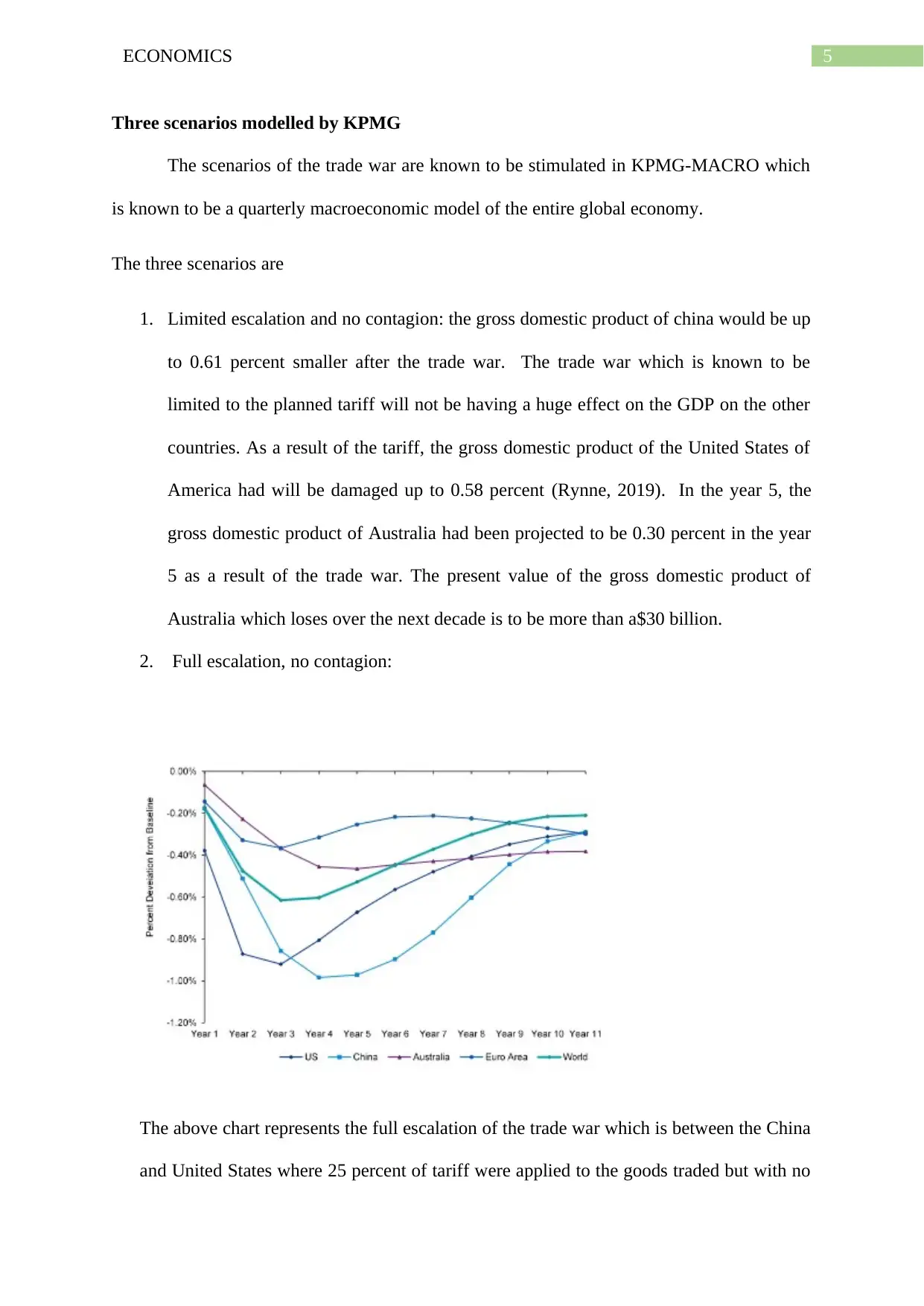
5ECONOMICS
Three scenarios modelled by KPMG
The scenarios of the trade war are known to be stimulated in KPMG-MACRO which
is known to be a quarterly macroeconomic model of the entire global economy.
The three scenarios are
1. Limited escalation and no contagion: the gross domestic product of china would be up
to 0.61 percent smaller after the trade war. The trade war which is known to be
limited to the planned tariff will not be having a huge effect on the GDP on the other
countries. As a result of the tariff, the gross domestic product of the United States of
America had will be damaged up to 0.58 percent (Rynne, 2019). In the year 5, the
gross domestic product of Australia had been projected to be 0.30 percent in the year
5 as a result of the trade war. The present value of the gross domestic product of
Australia which loses over the next decade is to be more than a$30 billion.
2. Full escalation, no contagion:
The above chart represents the full escalation of the trade war which is between the China
and United States where 25 percent of tariff were applied to the goods traded but with no
Three scenarios modelled by KPMG
The scenarios of the trade war are known to be stimulated in KPMG-MACRO which
is known to be a quarterly macroeconomic model of the entire global economy.
The three scenarios are
1. Limited escalation and no contagion: the gross domestic product of china would be up
to 0.61 percent smaller after the trade war. The trade war which is known to be
limited to the planned tariff will not be having a huge effect on the GDP on the other
countries. As a result of the tariff, the gross domestic product of the United States of
America had will be damaged up to 0.58 percent (Rynne, 2019). In the year 5, the
gross domestic product of Australia had been projected to be 0.30 percent in the year
5 as a result of the trade war. The present value of the gross domestic product of
Australia which loses over the next decade is to be more than a$30 billion.
2. Full escalation, no contagion:
The above chart represents the full escalation of the trade war which is between the China
and United States where 25 percent of tariff were applied to the goods traded but with no
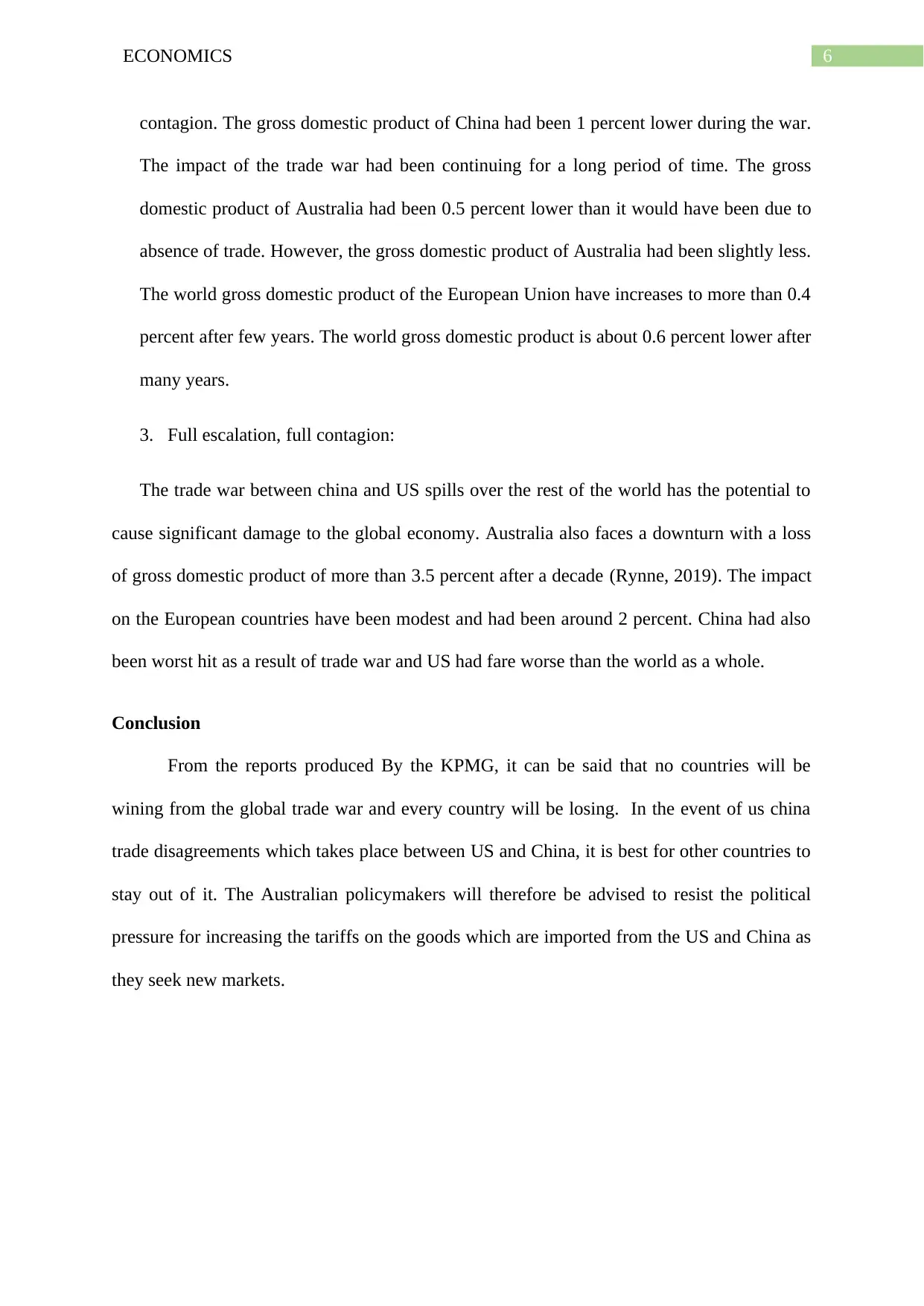
6ECONOMICS
contagion. The gross domestic product of China had been 1 percent lower during the war.
The impact of the trade war had been continuing for a long period of time. The gross
domestic product of Australia had been 0.5 percent lower than it would have been due to
absence of trade. However, the gross domestic product of Australia had been slightly less.
The world gross domestic product of the European Union have increases to more than 0.4
percent after few years. The world gross domestic product is about 0.6 percent lower after
many years.
3. Full escalation, full contagion:
The trade war between china and US spills over the rest of the world has the potential to
cause significant damage to the global economy. Australia also faces a downturn with a loss
of gross domestic product of more than 3.5 percent after a decade (Rynne, 2019). The impact
on the European countries have been modest and had been around 2 percent. China had also
been worst hit as a result of trade war and US had fare worse than the world as a whole.
Conclusion
From the reports produced By the KPMG, it can be said that no countries will be
wining from the global trade war and every country will be losing. In the event of us china
trade disagreements which takes place between US and China, it is best for other countries to
stay out of it. The Australian policymakers will therefore be advised to resist the political
pressure for increasing the tariffs on the goods which are imported from the US and China as
they seek new markets.
contagion. The gross domestic product of China had been 1 percent lower during the war.
The impact of the trade war had been continuing for a long period of time. The gross
domestic product of Australia had been 0.5 percent lower than it would have been due to
absence of trade. However, the gross domestic product of Australia had been slightly less.
The world gross domestic product of the European Union have increases to more than 0.4
percent after few years. The world gross domestic product is about 0.6 percent lower after
many years.
3. Full escalation, full contagion:
The trade war between china and US spills over the rest of the world has the potential to
cause significant damage to the global economy. Australia also faces a downturn with a loss
of gross domestic product of more than 3.5 percent after a decade (Rynne, 2019). The impact
on the European countries have been modest and had been around 2 percent. China had also
been worst hit as a result of trade war and US had fare worse than the world as a whole.
Conclusion
From the reports produced By the KPMG, it can be said that no countries will be
wining from the global trade war and every country will be losing. In the event of us china
trade disagreements which takes place between US and China, it is best for other countries to
stay out of it. The Australian policymakers will therefore be advised to resist the political
pressure for increasing the tariffs on the goods which are imported from the US and China as
they seek new markets.
⊘ This is a preview!⊘
Do you want full access?
Subscribe today to unlock all pages.

Trusted by 1+ million students worldwide
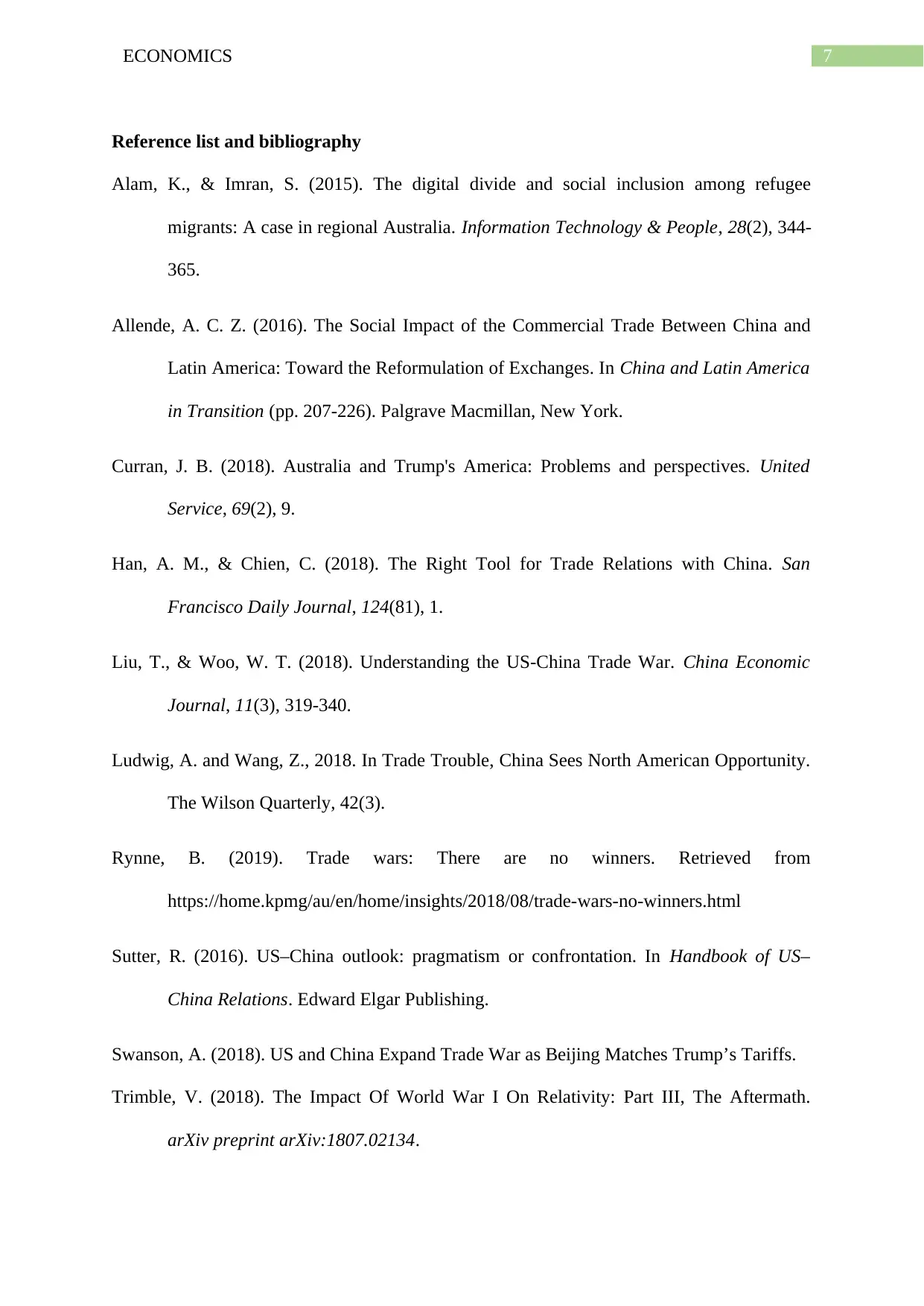
7ECONOMICS
Reference list and bibliography
Alam, K., & Imran, S. (2015). The digital divide and social inclusion among refugee
migrants: A case in regional Australia. Information Technology & People, 28(2), 344-
365.
Allende, A. C. Z. (2016). The Social Impact of the Commercial Trade Between China and
Latin America: Toward the Reformulation of Exchanges. In China and Latin America
in Transition (pp. 207-226). Palgrave Macmillan, New York.
Curran, J. B. (2018). Australia and Trump's America: Problems and perspectives. United
Service, 69(2), 9.
Han, A. M., & Chien, C. (2018). The Right Tool for Trade Relations with China. San
Francisco Daily Journal, 124(81), 1.
Liu, T., & Woo, W. T. (2018). Understanding the US-China Trade War. China Economic
Journal, 11(3), 319-340.
Ludwig, A. and Wang, Z., 2018. In Trade Trouble, China Sees North American Opportunity.
The Wilson Quarterly, 42(3).
Rynne, B. (2019). Trade wars: There are no winners. Retrieved from
https://home.kpmg/au/en/home/insights/2018/08/trade-wars-no-winners.html
Sutter, R. (2016). US–China outlook: pragmatism or confrontation. In Handbook of US–
China Relations. Edward Elgar Publishing.
Swanson, A. (2018). US and China Expand Trade War as Beijing Matches Trumpʼs Tariffs.
Trimble, V. (2018). The Impact Of World War I On Relativity: Part III, The Aftermath.
arXiv preprint arXiv:1807.02134.
Reference list and bibliography
Alam, K., & Imran, S. (2015). The digital divide and social inclusion among refugee
migrants: A case in regional Australia. Information Technology & People, 28(2), 344-
365.
Allende, A. C. Z. (2016). The Social Impact of the Commercial Trade Between China and
Latin America: Toward the Reformulation of Exchanges. In China and Latin America
in Transition (pp. 207-226). Palgrave Macmillan, New York.
Curran, J. B. (2018). Australia and Trump's America: Problems and perspectives. United
Service, 69(2), 9.
Han, A. M., & Chien, C. (2018). The Right Tool for Trade Relations with China. San
Francisco Daily Journal, 124(81), 1.
Liu, T., & Woo, W. T. (2018). Understanding the US-China Trade War. China Economic
Journal, 11(3), 319-340.
Ludwig, A. and Wang, Z., 2018. In Trade Trouble, China Sees North American Opportunity.
The Wilson Quarterly, 42(3).
Rynne, B. (2019). Trade wars: There are no winners. Retrieved from
https://home.kpmg/au/en/home/insights/2018/08/trade-wars-no-winners.html
Sutter, R. (2016). US–China outlook: pragmatism or confrontation. In Handbook of US–
China Relations. Edward Elgar Publishing.
Swanson, A. (2018). US and China Expand Trade War as Beijing Matches Trumpʼs Tariffs.
Trimble, V. (2018). The Impact Of World War I On Relativity: Part III, The Aftermath.
arXiv preprint arXiv:1807.02134.
Paraphrase This Document
Need a fresh take? Get an instant paraphrase of this document with our AI Paraphraser
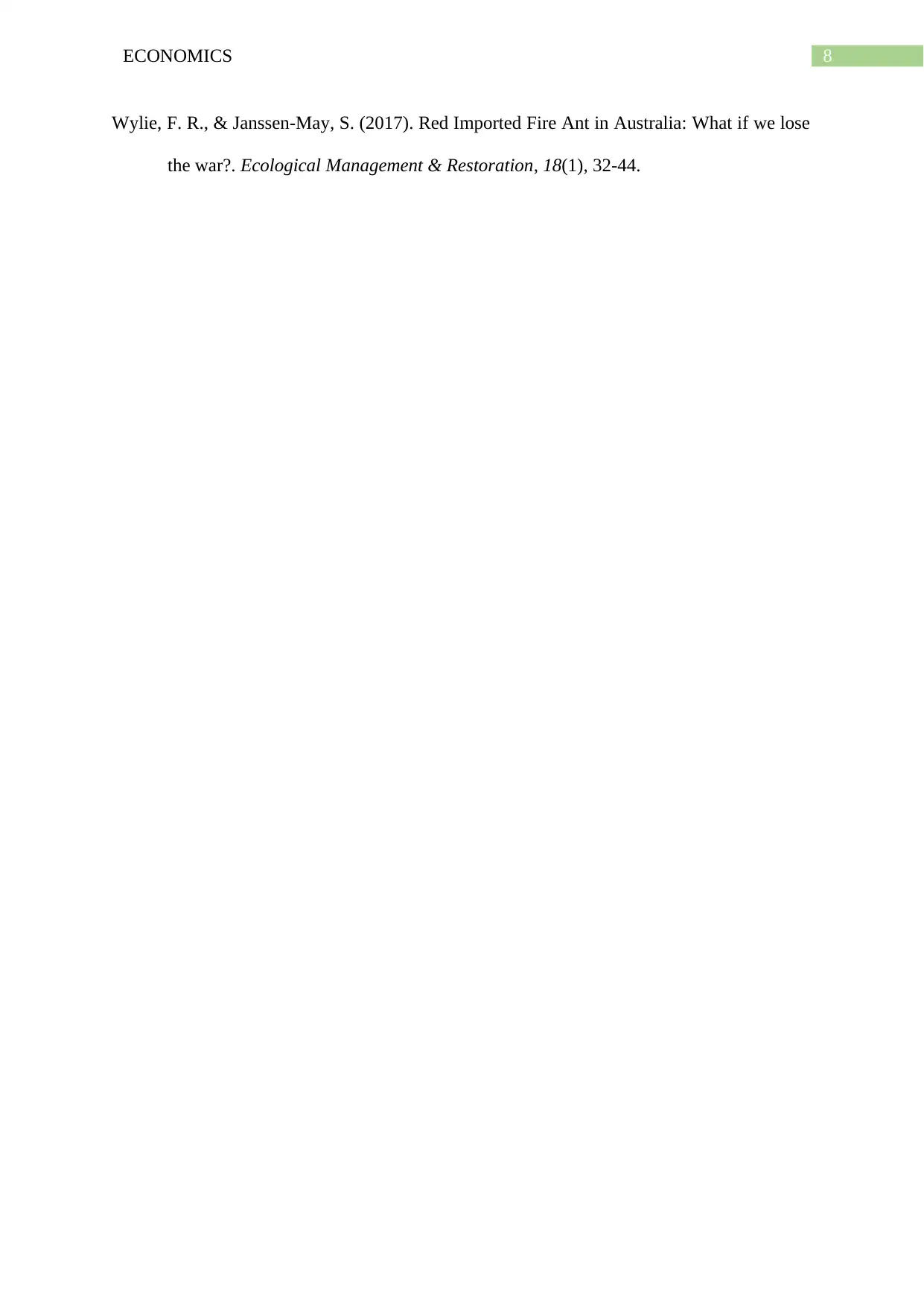
8ECONOMICS
Wylie, F. R., & Janssen‐May, S. (2017). Red Imported Fire Ant in Australia: What if we lose
the war?. Ecological Management & Restoration, 18(1), 32-44.
Wylie, F. R., & Janssen‐May, S. (2017). Red Imported Fire Ant in Australia: What if we lose
the war?. Ecological Management & Restoration, 18(1), 32-44.
1 out of 8
Related Documents
Your All-in-One AI-Powered Toolkit for Academic Success.
+13062052269
info@desklib.com
Available 24*7 on WhatsApp / Email
![[object Object]](/_next/static/media/star-bottom.7253800d.svg)
Unlock your academic potential
Copyright © 2020–2025 A2Z Services. All Rights Reserved. Developed and managed by ZUCOL.





